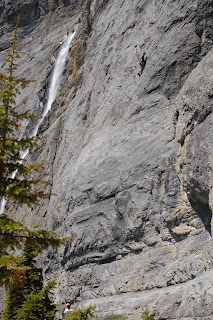The past while has been largely characterized by rain and a bit by disappointment. We did have one clear day about a week ago, in which Matt and I decided to go for Sisyphus (the 22-pitch 5.10d sport climb up Ha Ling peak in Canmore). Matt was at the top of the third pitch, getting reading to belay me up, when I heard a loud fluttering and saw shadows whiz past. My first thought was that we were under an attack by some rather angry birds; I carried this thought so far as to think to myself that we should tell the guys at the climbing shop in town and ask if they knew if this was a common nesting site or something. But then I realized that I was in fact right in the middle of a shower of bowl-sized rocks—just protected by a small roof over my head. The rock-fall lasted about fifteen seconds. Matt and I didn’t say anything for a few more seconds afterward—I think we both paused in a split between kind of wanting to carry on but thinking that the wise thing to do would be to retreat. I called up to him and we decided to rappel back down.
The next day we started to drive west. We made a stubborn attempt to climb at Lake Louise again in the not-so-good weather, and spent a few days just hanging out reading and playing cards.
On Wednesday we did a hike to the Walcott Quarry at the Burgess Shale—one of the world’s best fossil sites, where even imprints from soft-bodied creatures from the Cambrian explosion (about 505 million years ago) can be found. It is an amazing place to witness the evidence of some of evolution’s early experiments. There wasn’t space on the tour for me to go into the quarry itself, but I found quite a few intact trilobites on the trail below it, where pieces of shale collect after sliding down the hill.
After the hike, we continued our drive west . . . into Squamish, where we are now. Even though it had been raining here for the past two weeks here too, when we arrived we were welcomed by spots of blue showing through clouds that looked far friendlier than any we had seen for awhile. Looking at the Chief, the huge block of granite that is Squamish’s main attraction, made my hands start to sweat in anticipation of climbing again. Even though the rocks were still wet, we checked out some of the bouldering at the base of the chief as soon as we arrived. Yesterday we climbed some single-pitch cracks, then nearly dry.








